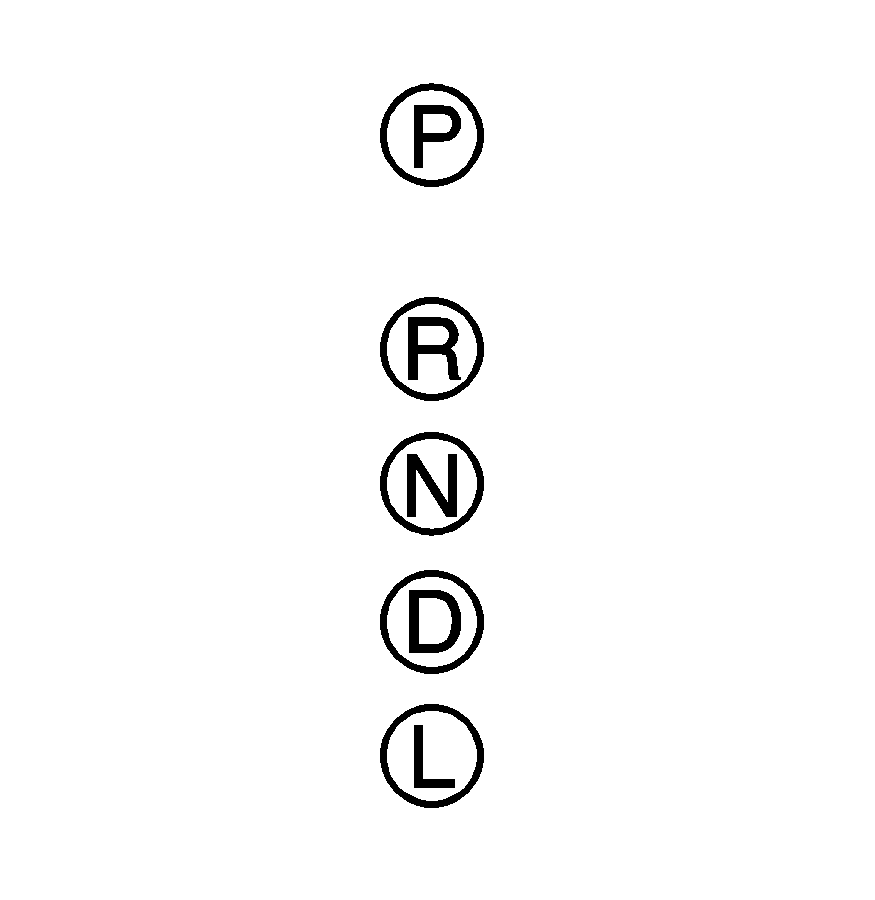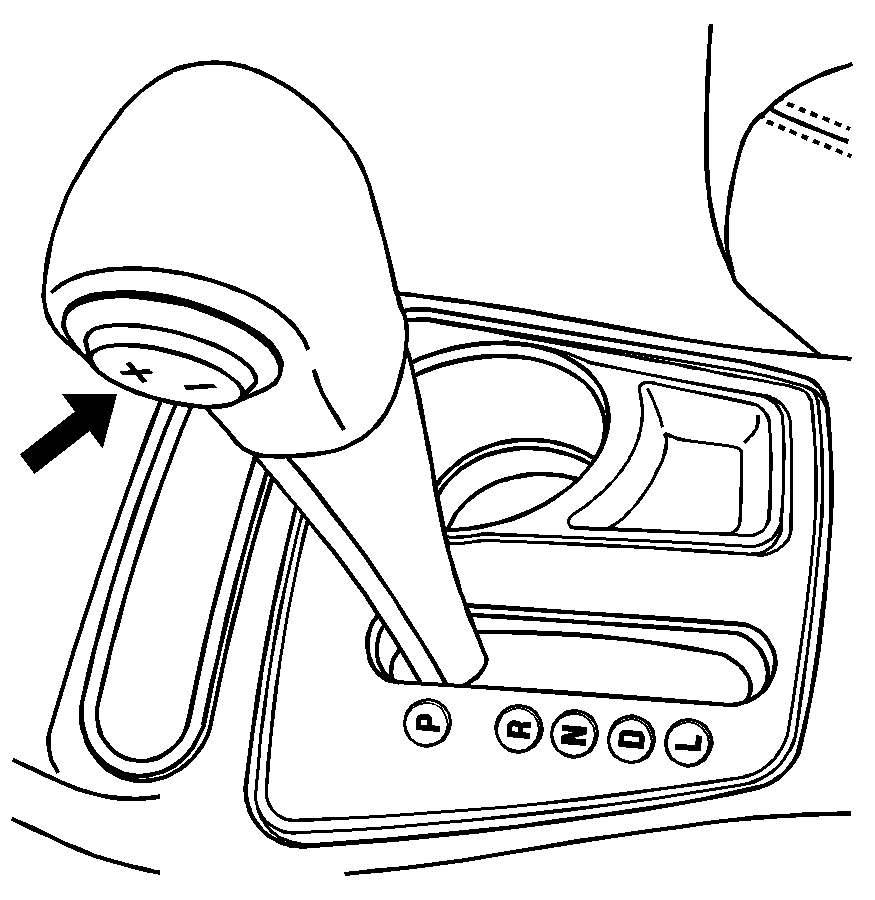Automatic Transaxle Operation Base Models

Your automatic transaxle has a shift lever located on the console between the seats.
PARK (P): This position locks your front wheels. It is the best position to use when you start your engine because your vehicle cannot move easily.Caution: It is dangerous to get out of the vehicle if the shift lever is not fully in P (Park) with the parking brake firmly set. The vehicle can roll.
Do not leave the vehicle when the engine is running unless you have to. If you have left the engine running, the vehicle can move suddenly. You or others could be injured. To be sure the vehicle will not move, even when you are on fairly level ground, always set the parking brake and move the shift lever to P (Park). See Shifting Into Park . If you are pulling a trailer, see Towing a Trailer .Make sure the shift lever is fully in PARK (P) before starting the engine. Your vehicle has an automatic transaxle shift lock control system. You must fully apply your regular brake first and then press the shift lever button before you can shift from PARK (P) when the ignition key is in ON. If you cannot shift out of PARK (P), ease pressure on the shift lever, then push the shift lever all the way into PARK (P) as you maintain brake application. Then press the shift lever button and move the shift lever into another gear. See Shifting Out of Park .
REVERSE (R): Use this gear to back up.Notice: Shifting to REVERSE (R) while your vehicle is moving forward could damage the transaxle. The repairs would not be covered by your warranty. Shift to REVERSE (R) only after your vehicle is stopped.
To rock your vehicle back and forth to get out of snow, ice or sand without damaging your transaxle, see If Your Vehicle is Stuck in Sand, Mud, Ice, or Snow .
NEUTRAL (N): In this position, your engine does not connect with the wheels. To restart when you are already moving, use NEUTRAL (N) only. Also, use NEUTRAL (N) when your vehicle is being towed.Caution: Shifting into a drive gear while the engine is running at high speed is dangerous. Unless your foot is firmly on the brake pedal, the vehicle could move very rapidly. You could lose control and hit people or objects. Do not shift into a drive gear while the engine is running at high speed.
Notice: Shifting out of PARK (P) or NEUTRAL (N) while the engine is running at high speed may damage the transaxle. The repairs would not be covered by your warranty. Be sure the engine is not running at high speeds when shifting your vehicle.
DRIVE (D): This position is for normal driving. It provides the best fuel economy for your vehicle. If you need more power for passing, and you are:| • | Going less than 35 mph (56 km/h), push your accelerator pedal about halfway down. |
| • | Going about 35 mph (56 km/h) or more, push the accelerator all the way down. |
Notice: If your vehicle seems to start up rather slowly or not shift gears when you go faster, and you continue to drive your vehicle that way, you could damage the transaxle. Have your vehicle serviced right away. You can drive in LOW (L2) when you are driving less than 35 mph (56 km/h) and DRIVE (D) for higher speeds until then.
LOW (L): This position gives you access to FOURTH, THIRD, SECOND and FIRST gear ranges. This provides more engine braking but lower fuel economy than DRIVE (D). You can use it on very steep hills, or in deep snow or mud. If the electronic range select is put in LOW (L), the transaxle will not shift into lower gears until the vehicle is going slow enough.Electronic Range Select Mode

This feature allows you to limit higher gears by selecting a maximum gear range when the shift lever is in LOW (L). The button for this mode is located on the left of the shift lever knob.
When the shift lever is first moved into LOW (L), the display in the instrument panel shows L3. Press the minus (-) end of the button on the shift lever once for L2 and once more for L1. Press the plus (+) end of the button once each to return to L2, L3 and L4. The shift lever must be moved back to DRIVE (D) to turn off the electronic range select mode.
L4 (LOW 4): This position does not limit gears, but provides more engine braking, and lower fuel economy, than DRIVE (D). The actual gear is determined by throttle and vehicle speed.L3 (LOW 3/DRIVE 3): This position prevents fourth gear operation. Actual gear is determined by throttle and vehicle speed.
L2 (LOW 2/DRIVE 2): This position prevents third and fourth gear operation. Actual gear is determined by throttle and vehicle speed. If you shift from L3 to L2 at vehicle speeds exceeding 80 mph (110 km/h), the transaxle will not shift into L2 gear until the vehicle is going slow enough.
L1 (LOW 1/DRIVE 1): This position prevents L2, L3, and L4 gear operation. If you shift from L2 to the L1 position at vehicle speeds exceeding 40 mph (65 km/h), the transaxle will not shift into L1 gear until the vehicle is going slow enough.
Automatic Transaxle Operation SS Models

Your automatic transaxle has a shift lever located on the console between the seats.
PARK (P): This position locks your front wheels. It is the best position to use when you start your engine because your vehicle cannot move easily.Caution: It is dangerous to get out of the vehicle if the shift lever is not fully in P (Park) with the parking brake firmly set. The vehicle can roll.
Do not leave the vehicle when the engine is running unless you have to. If you have left the engine running, the vehicle can move suddenly. You or others could be injured. To be sure the vehicle will not move, even when you are on fairly level ground, always set the parking brake and move the shift lever to P (Park). See Shifting Into Park . If you are pulling a trailer, see Towing a Trailer .Make sure the shift lever is fully in PARK (P) before starting the engine. Your vehicle has an automatic transaxle shift lock control system. You must fully apply your regular brake first and press the shift lever button before you can shift from PARK (P) while the ignition key is in ON. If you cannot shift out of PARK (P), ease pressure on the shift lever and push the shift lever all the way into PARK (P) as you maintain brake application. Then move the shift lever into another gear. See Shifting Out of Park .
REVERSE (R): Use this gear to back up.Notice: Shifting to REVERSE (R) while your vehicle is moving forward could damage the transaxle. The repairs would not be covered by your warranty. Shift to REVERSE (R) only after your vehicle is stopped.
To rock your vehicle back and forth to get out of snow, ice, or sand without damaging your transaxle, see If Your Vehicle is Stuck in Sand, Mud, Ice, or Snow .
NEUTRAL (N): In this position, your engine does not connect with the wheels. To restart when you are already moving, use NEUTRAL (N) only. Also, use NEUTRAL (N) when your vehicle is being towed.Caution: Shifting into a drive gear while the engine is running at high speed is dangerous. Unless your foot is firmly on the brake pedal, the vehicle could move very rapidly. You could lose control and hit people or objects. Do not shift into a drive gear while the engine is running at high speed.
Notice: Shifting out of PARK (P) or NEUTRAL (N) while the engine is running at high speed may damage the transaxle. The repairs would not be covered by your warranty. Be sure the engine is not running at high speeds when shifting your vehicle.
DRIVE (D): This position is for normal driving. It provides the best fuel economy for your vehicle. If you need more power for passing, and you are:| • | Going less than 35 mph (55 km/h), push your accelerator pedal about halfway down. |
| • | Going about 35 mph (55 km/h) or more, push the accelerator all the way down. |
Driver Shift Control (DSC)
This feature allows you to select lower or higher driving gears when the shift lever is in MANUAL MODE (M). The button for this mode is located on the left side of the shift lever knob.
To use this feature, do the following:
- Move the shift lever from DRIVE (D) rearward into the MANUAL MODE (M). The vehicle will be in the MANUAL MODE (M) and a gear based on the current driving speed.
- Press the plus (+) button to upshift or the minus (-) button to downshift.
While driving in MANUAL MODE (M), the transaxle will remain in the selected drive gear unless:
| • | A shift is required to protect the engine or transaxle or, |
| • | The vehicle slows almost to a stop (the vehicle will automatically downshift) |
When the shift lever is first moved into MANUAL MODE (M), the display on the instrument panel cluster shows M1, M2, M3, M4. Position M for the manual mode and a number representing the gear the transaxle is in. Press the minus (-) end of the button on the shift lever to downshift. Press the plus (+) end of the button to upshift. The shift lever must be moved back to DRIVE (D) to turn off the manual mode and return to fully automatic shifting.
While using the Driver Shift Control (DSC) feature the vehicle will have firmer shifting and increased performance. You can use this for sport driving or when climbing hills to stay in gear longer or to downshift for more power or engine braking.
The transaxle will only allow you to shift into gears appropriate for the vehicle speed and engine revolutions per minute (RPM). The transaxle will not automatically shift to the next higher gear if the engine RPM is too high.
When coming to a stop in the manual mode, the vehicle will automatically downshift to the proper gear based on speed. Upon acceleration you will need to manually upshift to the desired gear.
Second Gear Start Feature
When accelerating your vehicle from a stop in snowy and icy conditions, you may want to shift the gear select tap switch into Second gear. A higher gear allows you to gain more traction on slippery surfaces.
With the DSC feature, the vehicle can be set to pull away in Second gear.
- Move the shift lever from DRIVE (D) into the MANUAL MODE (M).
- With the vehicle stopped, press (+) end of the button to select Second gear. The vehicle will start from a stop position in Second gear.
- Once moving select the desired drive gear.
